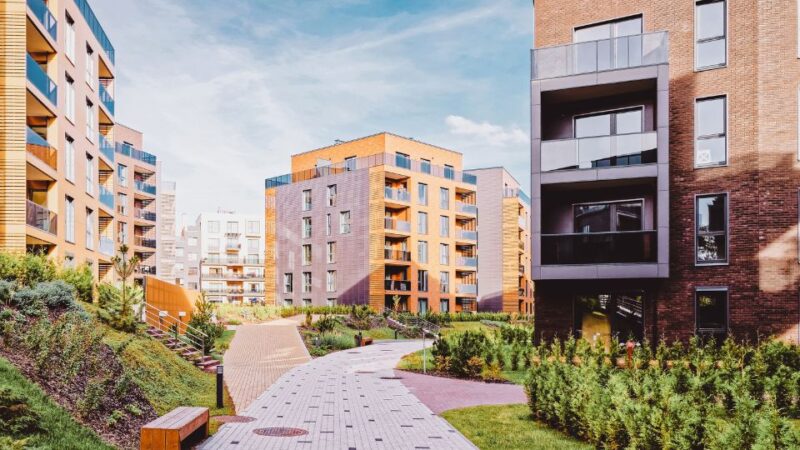The multifamily lending market took a sharp downturn in 2023, experiencing a 49% decline to $246 billion, according to the Mortgage Bankers Association (MBA). However, as of the second quarter of 2024, there has been a modest rebound in overall commercial and multifamily borrowing, with a 3% increase compared to the previous quarter.
These contrasting figures illustrate the shifting landscape of real estate finance, with multifamily lending facing severe setbacks last year. With the recent decline in interest rates, overall commercial lending volume shows signs of a recovery. Here’s a detailed look at the factors driving these trends and what lies ahead.
A Steep Decline in 2023 Multifamily Lending
The year 2023 was one for the record books, but not in a good way. The multifamily lending sector, once a robust area of real estate finance, saw a dramatic reduction in activity. The $246 billion in multifamily loan originations in 2023 marked a nearly 50% drop from the previous year’s $487 billion. This significant decline is the largest percentage drop since the global financial crisis of 2008.
The sharp fall is primarily attributed to higher interest rates and tighter financial conditions that severely impacted borrowing capacity. MBA’s Head of Commercial Real Estate Research, Jamie Woodwell, noted, “2023 was the slowest year for commercial real estate borrowing and lending in roughly a decade as rising interest rates, declining property values, and broad economic uncertainty took their toll.” Multifamily properties were particularly affected as the rise in rates outpaced rental growth, putting pressure on developers and investors alike.
Further complicating matters were challenges in property valuation. As interest rates surged, the capitalization rates that investors used to determine a property’s value also increased. This pushed down the potential resale value of multifamily assets. This created a vicious cycle where investors were unable or unwilling to finance new projects, causing a steep reduction in lending activity.
Woodwell continued, “Multifamily lending fell by roughly half in 2023 as sales transactions declined and far fewer property owners sought to refinance their loans. The analysis shows that even with the drop in activity, the multifamily lending market remains broad and deep, with more than 2,500 different lenders making more than 36,000 mortgage loans backed by multifamily properties in amounts ranging from tens of thousands of dollars to hundreds of millions.”
The top five multifamily lenders in 2023 by dollar volume were Berkadia, Walker & Dunlop, JPMorgan Chase, CBRE, and Greystone. These companies led the market despite the sharp decline in multifamily lending and continued to facilitate financing through the challenges of 2023.
As loans matured, many lenders turned to modifications and extensions—often referred to in the industry as ‘extend and pretend.’ By extending these loans, both the lenders and their constrained borrowers, hold out hope that interest rates will eventually return to the heady days of 2018-2022. A nice boost in valuations based on a decline in cap rates would be the cherry on top.
Related: How do Interest Rates Impact Multifamily Property Financing and Investments?
A Modest Rebound in 2024
Despite these previous challenges in 2023, the tide is indeed slowly turning. In the second quarter of 2024, commercial and multifamily mortgage loan originations increased by 3%, according to MBA’s recent survey. This growth reflects the beginning of a rebound, bolstered by renewed investor confidence and improving economic conditions.
The uptick in lending is largely being driven by the commercial sector. Key segments such as industrial, retail, and medical office spaces have demonstrated resilience amid challenging macroeconomic conditions. These sectors have shown the ability to adapt to shifting consumer behaviors and technological advancements, which has translated into steady demand for financing. Multifamily lending, though still lagging behind pre-2023 levels, also contributed to this growth, as demand for rental housing remains strong in many urban areas.
According to the MBA, multifamily lending is expected to recover further throughout 2024, with projections of a 25% increase to $339 billion. Woodwell commented on this optimistic outlook, stating, “As we look forward, there are reasons for cautious optimism. Market fundamentals for rental housing remain strong, and we expect demand to remain stable, which should support a recovery in multifamily lending.”
Related: DOJ Sues RealPage Over Algorithmic Pricing: Is AI Fixing or Inflating Rents?
Comparing Timeframes and Factors
The stark contrast between 2023’s downturn and 2024’s modest recovery is a study in timeframes and macroeconomic factors. In 2023, the primary culprits behind the decline in lending were rising interest rates and inflationary pressures. As central banks worldwide raised rates to combat inflation, the cost of borrowing increased across the board. This was compounded by broader economic uncertainty, which caused many investors to hold back on new developments or expansions.
By contrast, 2024 has seen a stabilization in economic conditions, though uncertainties remain. Interest rates, while still high, have shown signs of leveling off, and inflation has begun to recede in many advanced economies. This shift has allowed investors to re-enter the market, particularly in sectors with strong fundamentals such as industrial and multifamily housing.
The recovery, however, is uneven. While commercial borrowing is on the rise, multifamily lending remains subdued relative to pre-pandemic levels. Factors such as regional variations in housing demand, labor shortages in construction, and the availability of affordable housing play crucial roles in the slower recovery of multifamily lending.
Commercial and Multifamily Lending – The Long-Term Outlook
Looking ahead, the long-term outlook for commercial and multifamily lending is cautiously optimistic for most industry veterans. The MBA forecasts total commercial and multifamily mortgage borrowing and lending to rise by 29% in 2024, reaching $576 billion.
Multifamily lending is expected to account for $339 billion of that total. The recovery, though steady, will likely remain constrained by the cost of capital and the uncertainty surrounding future interest rate movements.
One area of focus for the future is the potential for office-to-residential conversions. As work patterns continue to evolve post-pandemic, many commercial office buildings may be repurposed for residential use. This trend could provide a new avenue for multifamily lending, particularly in urban areas where demand for housing remains strong but new construction is limited.


